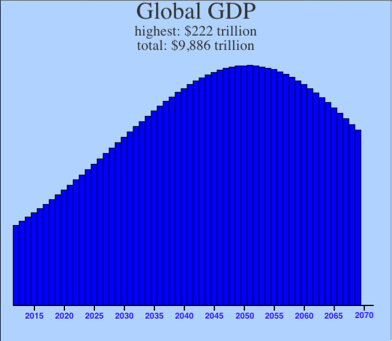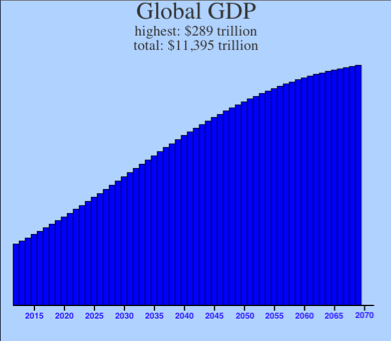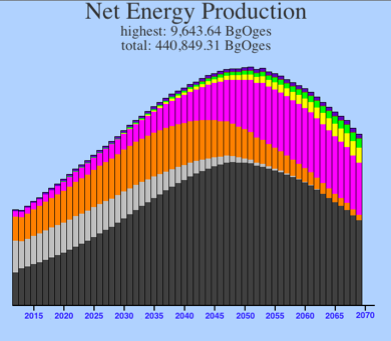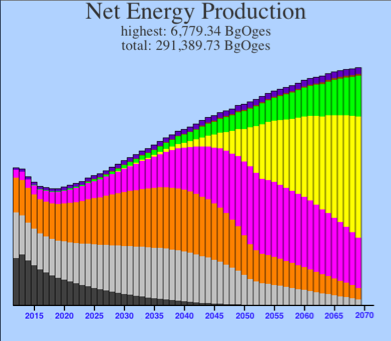I have finally gotten what I’ve been striving for all this time:


Business as Usual Scenario $100/ton CO2 tax
Here are the energy production histories for the two scenarios:


Business as Usual Scenario $100/ton CO2 tax
It took an enormous amount of fiddling (perhaps you’ve noticed from the diaries over the last few months) to get a proper balance. What I don’t show here are the results for high-tax scenarios; in these, the GDP gets clobbered by the high taxes. But in the $100/ton scenario, I’ve finally gotten the correct balance between the destructive effects of climate change and the destructive effects of taxation.
There is one problem with the GDP curve: it really should go down at first. In other words, the taxation scenario should cause some short-term pain, but lead to long-term benefit. Given how difficult it has been to get to this point, I suppose I’d be prudent to accept this shortcoming.
With this obstacle at last overcome, I’m hoping that the worst is behind me. From this point forward, my task is to adjust the various consequent factors. Here are some of the issues I’m now considering:
Do I have the right subsidies?
Currently I have these five:
Basic Research, Solar Technology Research, Wind Technology Research, Conservation Technology Research, Public Transport
What bothers me about these is the huge amount of money being spent on them. For example, in the C100 scenario ($100 per ton of CO2), we spend about $500 billion per year on each of the three research areas. That’s absurd. It is impossible to spend that much money productively on research; most of it would be wasted. So I need to reduce the research. I could reduce it to two categories: basic and applied. Or I could reduce it to a single category: research.
What would I put in its place? Here are some candidates:
Food Aid
A big negative factor in the game is malnutrition, which kills several million people per year. Spending some money on food aid would help here. The problem lies in the magnitude of the numbers: $500 billion per year would pretty much make malnutrition go away. But isn’t that too easy?
Global Capital Fund
We take money out of the energy economy and redirect it to other investments. This would boost the economy. If I do this, I’ll have to counter the boost by making rising energy prices more destructive to the economy. The current value of the elasticity of GDP in response to energy prices is 1.33. In other words, a 1% increase in energy prices reduces GDP by 1.33%. It’s actually a bit more complicated than that because it also triggers increases in energy conservation, which ultimately increase GDP, so the effect elasticity comes out to maybe 1.0. Now, theoretically an elasticity greater than 1.0 is a very rare situation; most elasticities fall between 0.1 and 0.5. To counter the effects of increased capital availability, I’d have to increase the elasticity, which is already too high. I don’t like that.
Education
I once had education as a factor in the game. It reduced population growth and it fed into a factor called services, which are a growing portion of the global economy and will be the primary component sometime this century. Services don’t take a lot of energy to generate a lot of GDP, so they reduce the importance of energy in the economy, making it easier to grow despite increases in the price of energy. The problem I had was that the player could devote enormous amounts of money to education and solve all the problems of the world too easily. That should be fixable, but it certainly was a pain.
Direct Energy Subsidies
Use the tax revenues to subsidize the purchase of renewable energy facilities. This lowers their effective price and increases their usage. I had this in place at one point, but it didn’t have much effect, because the capital costs of renewable energy are so high. $500 billion a year to spend on renewable energy really won’t buy much energy in the grand scheme of global energy production. Still, it might be useful to provide this option if only to demonstrate its inutility.
The problem with all of these is that they add complexity to a simulation that is already way too complicated. But let’s assume that I’m going to ignore that problem. I have six candidates: Research, Public Transport, Food Aid, Global Capital Fund, Education, and Direct Energy Subsidies. I can only implement five because of space restrictions on the screen. Which one do I ditch? After mulling around, I think the the Global Capital Fund is the weakest candidate, because it will be difficult for the player to comprehend.
That, for the moment, is my conclusion. Let’s see how well it stands up to the test of implementation.
